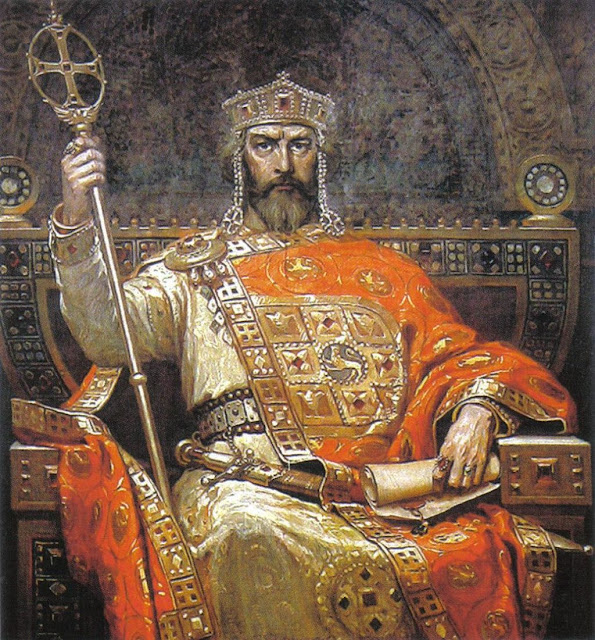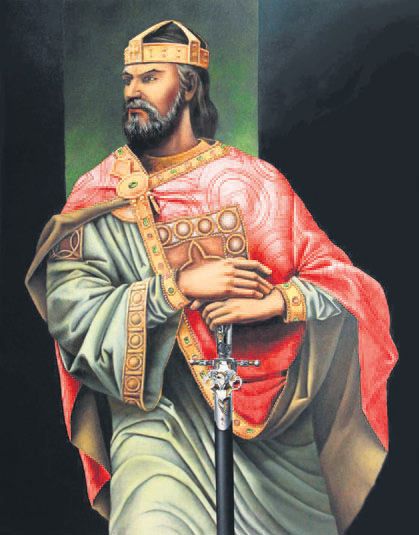St Theodore of Sykeon, (d. 613)
Saint Theodore of Sykeon was a revered Byzantine ascetic, who lived between the first half of the 6th century and the thirteenth year of the Emperor Heraclius' rule (i. e. 623) in the early 7th century.
Theodore was born in Sykeon, a village in Galatia. The public highway of the imperial post ran through this village, and on the road stood an inn kept by a very beautiful girl, Mary, her mother, Elpidia, and a sister Despoinia. And these women lived in the inn and followed the profession of courtesans. Theodore was the son of Mary.
Anton Raphael Mengs, (1728–1779)
Saint John the Baptist Preaching in the Wilderness, c. 1760s
Oil on canvas
Height: 214.6 cm (84.4 in); Width: 148 cm (58.2 in)
Museum of Fine Arts, Houston
Anton Raphael Mengs (March 22, 1728[1] – June 29,
1779) was a German painter, active in Dresden, Rome and Madrid, who
while painting in the Rococo period of the mid-17th century became one of the
precursors to Neoclassical painting that replaced Rococo as the dominant
painting style.
In 1749 he
was appointed first painter to Frederick Augustus, elector of Saxony, but this
did not prevent him from continuing to spend much of his time in Rome. He
converted to Catholicism, and in 1754 he became director of the Vatican school
of painting. His fresco painting of Parnassus at Villa Albani gained him a
reputation as a master painter.
In 1749
Mengs accepted a commission from the Duke of Northumberland to make a copy, in
oil on canvas, of Raphael's fresco The School of Athens for his London home.
On two occasions he accepted invitations from Charles III
of Spain to go to Madrid. There he produced some of his best work, most notably
the ceiling of the banqueting hall of the Royal Palace of Madrid. After the
completion of this work in 1777, Mengs returned to Rome, where he died two
years later, in poor circumstances, leaving twenty children, seven of whom were
pensioned by the king of Spain. More on Anton
Raphael Mengs
When he was about twelve years old an epidemic of bubonic plague fell upon the village and it attacked him along with others so that he came near to dying. They took him to the shrine of St. John the Baptist near the village and laid him at the entrance to the sanctuary; he recovered and returned home.
Unknown artist
Miracle of St. George about the serpent, c. Mid 14th century Novgorod
State Tretyakov Gallery, Moscow
He used to frequent a shrine dedicated to the martyr St. George, located up the rocky hill which lay near the village. At the age of fourteen, he went there to live. Even at such a young age, Theodore was granted the gift of healing. Theodore also became well known for serving his neighbors with his gifts of exorcism, and prophecy.
Theodore then withdrew into complete solitude, to a cave not far from the oratory of St George. He persuaded a deacon to bring him bread and water, and he told no one else where he had hidden himself.
For two years St Theodore lived in this seclusion until news of the youth’s exploits reached the local bishop Theodosius, who ordained him to the diaconate, and later to the holy priesthood, although the saint was only seventeen years old at the time. He was later chosen Bishop of Anastasioupolis.
Unknown artist
Emperor Maurice (r. 582–602)
During the reign of Emperor Maurice (r. 582–602), he foretold the emperor's death and "great tribulations, terrible scourges threaten the world." Maurice's reign was troubled by financial difficulties and almost constant warfare. In 602 a dissatisfied general named Phocas usurped the throne, having Maurice and his six sons executed. This event would prove a disaster for the Empire, sparking a twenty-six year war with Sassanid Persia. St Theodore was a close friend of the family of Emperor Phocas.
Unknown artist
The Sassanid Army
Unknown artist
Heraclius
St. Theodore of Sykeon had good relations with Patriarch Sergius of Constantinople. Still, historian Walter Kaegi says that Heraclius "may always have felt some reserve in his relations with" St. Theodore. During Lent 613, Heraclius asked for St. Theodore's blessing in fighting the Persians. St. Theodore blessed him and invited him to dinner, but Heraclius refused because of time concerns. However, the saint claimed that not accepting his gifts was a "sign of our defeat". Indeed, Heraclius lost the Battle of Antioch.
He died on April 22, 613. More on St. Theodore of Sykeon
Please visit my other blogs: Art
Collector, Mythology, Marine
Art, Portrait of a Lady, The
Orientalist, Art of the Nude and The
Canals of Venice, Middle
East Artists, and 365 Saints, also visit my Boards on Pinterest
Images are copyright of their
respective owners, assignees or others. Some Images may be subject to copyright
I don't own any of these images -
credit is always given when due unless it is unknown to me. if I post your
images without your permission, please tell me.
I do not sell art, art prints, framed
posters or reproductions. Ads are shown only to compensate the hosting
expenses.
If you enjoyed this post, please share
with friends and family.
Thank you for visiting my blog and also
for liking its posts and pages.
Please note that the content of this
post primarily consists of articles available from Wikipedia or other free
sources online.







No comments:
Post a Comment
Note: Only a member of this blog may post a comment.